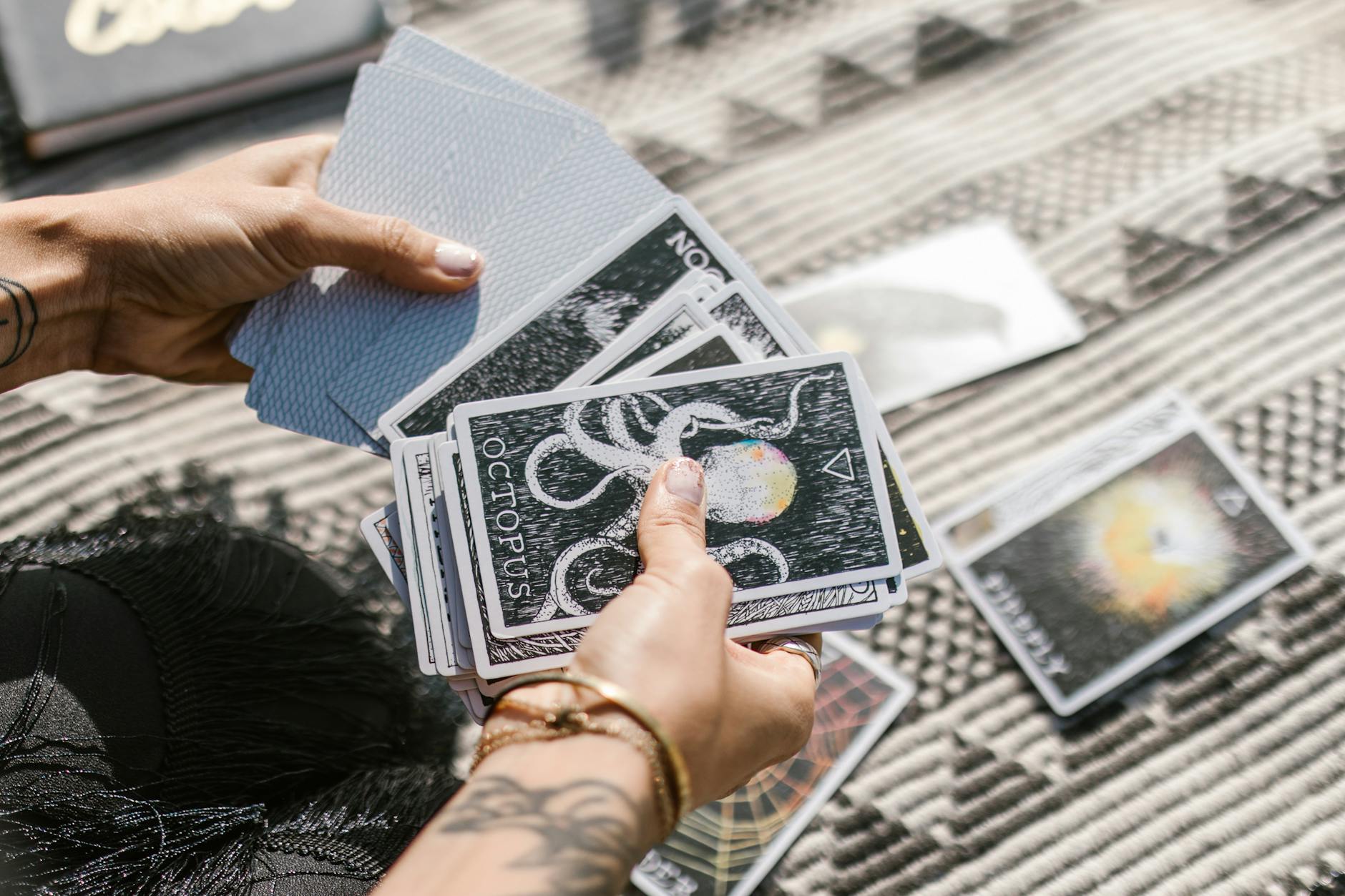No products in the cart.
No products in the cart.
Tarot and Lenormand readings have fascinated people for centuries, offering two distinct ways to explore questions and gain insights. Tarot, with origins tracing back to 15th-century Europe, is a rich, symbolic system of 78 cards divided into the Major and Minor Arcana.
Lenormand, created in the late 18th century, is a smaller 36-card deck with straightforward imagery tied to everyday themes. Both have grown in popularity, valued for their ability to guide personal decisions and reflect on life’s challenges. Whether you seek detailed symbolism or practical clarity, these two methods offer unique approaches to divination.
Let’s explore what sets them apart.
Tarot is an ancient practice that combines symbolism and intuition to explore questions and uncover deeper insights. It’s a tool that helps people reflect on life’s challenges and opportunities while offering guidance. To truly appreciate its depth, let’s break it down into some key elements.
At first glance, a Tarot deck might feel overwhelming, but its structure is quite methodical. A typical deck contains 78 cards, divided into two main categories:
Each card holds unique energy and meaning, and the interplay between Major and Minor Arcana in a reading creates a layered narrative.
 Photo by Mikhail Nilov
Photo by Mikhail Nilov
One of the most fascinating aspects of Tarot is its rich use of symbols. Each card is a visual feast, brimming with complex imagery and hidden meanings. These symbols come from various influences, such as astrology, numerology, mythology, and psychology.
For example:
Readers interpret these symbols based on the context, helping seekers uncover insights that might not be immediately obvious. If you’re curious to explore more about card symbolism, you can find detailed card descriptions here.
The magic of Tarot lies in how the cards work together during a reading. First, the reader selects (or has the client pick) cards to lay out in specific spreads. A spread determines how the cards are positioned and interacted with for clarity. For instance:
Intuition plays a huge role. A skilled Tarot reader doesn’t just rely on memorized card meanings. Instead, they weave together the imagery, positioning, and “feel” of the cards to provide a narrative unique to the client’s question or situation.
People turn to Tarot for a variety of reasons. Often, it’s about seeking clarity or confirming what they already suspect. Here are some common areas where Tarot shines:
Whether you’re using it for practical advice or spiritual exploration, Tarot offers a unique way to navigate life’s twists and turns. For beginners, a helpful resource like this guide can deepen your understanding of the cards.
In the next sections, we’ll explore the nuanced differences that separate Tarot from Lenormand readings while diving deeper into what makes both systems unique.
Lenormand card reading is known for being remarkably straightforward, offering clear and concise answers to your questions. Unlike Tarot, which leans heavily toward symbolism and intuition, Lenormand focuses on practical interpretations that are easy to follow and apply in real life. Let’s break down the core features that make the Lenormand system unique.
A Lenormand deck consists of 36 cards, each with predefined meanings tied to everyday life. Unlike Tarot with its expansive symbology, Lenormand cards rely on simple imagery and direct associations that make them easier to interpret. For example:
Each card has a fixed meaning, which allows for less ambiguity compared to Tarot. Because of this practicality, the Lenormand deck has gained popularity among those looking for quick insights or definitive answers. You can further explore detailed card meanings here.
One of the standout features of Lenormand reading is how the meanings are derived by combining cards. Each card is like a word, and when paired with another card, they form a phrase. For instance:
This emphasis on combinations makes Lenormand especially logical and structured. While Tarot readings draw heavily on intuition and symbolic layers, Lenormand uses a more straightforward linguistic approach. If you want to dive deeper into how Lenormand cards are paired, this guide is an excellent place to start.
The Grand Tableau is the signature spread of Lenormand, offering a comprehensive overview of your life or situation. Unlike typical spreads that use a handful of cards, this method places all 36 cards on the table in a grid format. Each card interacts with its surrounding cards, creating a complex web of insights.
In a Grand Tableau, cards are read in relation to their position on the grid and their connection with others. For example:
This spread is ideal for those seeking a “big picture” view, as it examines multiple aspects of life in one session. It’s the ultimate tool for advanced Lenormand readers. Learn more about how to read the Grand Tableau here.
Lenormand readings excel in providing quick, clear answers to specific questions. Its practicality makes it a go-to choice for daily guidance and decision-making. Here are some examples of how Lenormand readings can be applied:
Curious about how Lenormand fits into your life? Explore its unique traits and applications here. Its ability to guide, clarify, and forecast makes Lenormand a powerful—but surprisingly user-friendly—tool for anyone seeking insights.
Lenormand offers a refreshing alternative to the symbolic depth of Tarot, appealing to those who prefer logic and a straightforward reading style.
When it comes to divination, both Tarot and Lenormand have carved out their unique spaces as powerful tools for self-discovery and guidance. Though both involve cards and interpretation, their methods, symbolism, and intended outcomes differ significantly. Below, we’ll explore these variations to help you understand which style might suit your needs better.
One of the most striking contrasts between Tarot and Lenormand is how they approach interpretation. Tarot readings often lean on intuition to guide the process. The richly detailed imagery of each card allows readers to weave personal impressions alongside fixed meanings. This makes Tarot highly individualized—the same card can elicit different insights depending on the reader or the situation.
Lenormand, on the other hand, is far more logical and structured. Its cards have set, almost rigid meanings that rarely rely on personal interpretation. When performing a reading, Lenormand readers combine the meanings of multiple cards, much like forming a sentence. This pragmatic approach ensures clarity and reduces ambiguity.
For example:
If you’re comfortable with free-flowing intuition, Tarot might feel like a natural fit. But if you prefer direct and precise messaging, Lenormand’s logical style may resonate better.
Let’s consider the learning journey of each deck. Tarot carries a reputation for being complex yet rewarding. With a deck of 78 cards, divided into Major and Minor Arcana, Tarot dives deep into symbolism, mythology, and even aspects like numerology and astrology. It’s not merely about memorizing card meanings; it’s about understanding how stories emerge during readings.
By contrast, Lenormand is refreshingly straightforward. With only 36 cards and a strong emphasis on clear, predefined meanings, it’s much easier to pick up. Beginners often find Lenormand less intimidating, as you won’t need to dissect mystical themes or search for hidden layers of meaning.
Think of it this way—Tarot is like learning chess, rich in strategy but requiring mastery of the rules. Lenormand is closer to checkers: simple to start, yet still capable of delivering profound insights. For a deeper understanding of how these differences shape readings, check out this blog on their fundamental contrasts.

Photo by Pavel Danilyuk
A key difference in these systems is the type of imagery they employ. Tarot often uses esoteric and archetypal symbols, drawing from mythology, psychology, and spiritual traditions. Its cards can feature intricate illustrations—think of planets, mystical creatures, and ethereal landscapes. This abstract quality invites introspection and deeper exploration.
Lenormand, in contrast, thrives on everyday imagery. Its symbols are plain and relatable, such as a house, a bouquet, or a cloud. This mundane approach doesn’t detract from its power; instead, it makes readings highly accessible and grounded in reality.
For example:
This difference highlights how Lenormand is more about tangible, actionable advice, while Tarot leans toward introspection and personal growth. If you’d like to learn more about the nuances of each system’s imagery, this article breaks it down perfectly.
Finally, it’s important to understand the broader purpose of each system. Tarot is often used for self-reflection and spiritual exploration. Its expansive imagery and symbolism allow it to address complex questions about life’s purpose, emotional growth, or personal development. It’s perfect for anyone seeking deeper awareness and context.
Lenormand, however, is all about practical answers. Its direct nature makes it ideal for binary questions, predicting events, or uncovering specific information. If you’re wondering, “Will I get the job?” or “Is this relationship worth pursuing?” Lenormand offers quick, no-nonsense clarity.
In essence:
Each deck serves its purpose beautifully. Whether you crave rich narratives or clear solutions, there’s a method suited to your needs.
If you’re deciding whether Tarot or Lenormand suits you better, it ultimately comes down to personal preferences and goals. Both systems offer profound insights, but their methods vary greatly. Below, we’ll break down the key aspects to think about when choosing between Tarot and Lenormand.
Are you someone who enjoys interpreting abstract meanings, or do you prefer direct answers? This is a decision that can guide you when choosing between Tarot and Lenormand.
Which resonates with you more—the freedom of creativity or the clarity of logic? Both have their pros, and your personality may tilt you toward one system over the other. For a detailed look at these approaches, you can check out this comparison.
What you want to ask or uncover also plays a big role when choosing between Tarot and Lenormand.
Think of Tarot as a tool for understanding the big picture, while Lenormand is like consulting a trusted friend with a quick, direct answer. The choice depends on what type of insight you need. To weigh the pros of each system, this guide is a helpful resource.

Photo by RDNE Stock project
Why choose one when you can use both? Tarot and Lenormand can complement each other beautifully, creating a well-rounded approach to your readings.
This combination allows you to tackle practical questions and deeper emotional insights in one session. It’s a bit like pairing logic with creativity—each enhances and balances the other. Interested in learning more about blending these systems? Explore tips on this insightful blog.
Tarot and Lenormand are both powerful tools, but their strengths lie in different areas. Tarot offers deep, symbolic exploration, while Lenormand delivers clear and direct insights. They cater to different needs, whether you’re seeking introspection or straightforward answers.
Experimenting with both systems can help you discover which resonates most with your personality and goals. You might even find that combining the two provides a balanced approach to your readings.
Whether you’re drawn to the layered symbolism of Tarot or the crisp clarity of Lenormand, both can offer meaningful guidance. Which style speaks to you? Try a reading today and start your journey.



